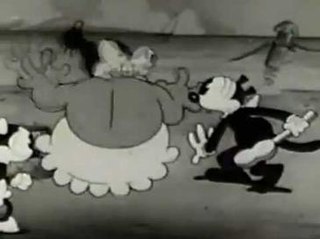
Emmanuel Gould was an American animated cartoonist from the 1920s to the 1970s, best known for his contributions as a director, writer and animator for Screen Gems, and solely an animator for Warner Bros. Cartoons and DePatie–Freleng Enterprises.
Ratskin is a 1929 animated cartoon released by Columbia Pictures starring Krazy Kat. It is the first cartoon to be released by Columbia Pictures and the first Krazy Kat cartoon released with sound.

Weenie Roast is a 1931 short animated cartoon distributed by Columbia Pictures. It stars Krazy Kat.

Rodeo Dough is a 1931 American short animated Western film by Columbia Pictures, and stars the comic strip character Krazy Kat.
Seeing Stars is a 1932 short animated film distributed by Columbia Pictures, and features Krazy Kat. Different from most shorts of the series, the cartoon features celebrities in their animated forms.
Port Whines is a 1929 animated short film by the Columbia Pictures Corporation. It is the 136th Krazy Kat cartoon.
Lil' Ainjil is a 1936 short animated film distributed by Columbia Pictures, and features Krazy Kat.

Bars and Stripes is a 1931 short film from Columbia Pictures, part of the Krazy Kat theatrical cartoons.
Alaskan Knights, also known as Animal Rhythm is some reissues, is an animated cartoon by Columbia Pictures, part of the Krazy Kat series.

Krazy Spooks is a 1933 short animated film distributed by Columbia Pictures and is among the theatrical cartoons featuring Krazy Kat.
The Mouse Exterminator is a 1940 short animated film in the Phantasies series, produced and distributed by Columbia Pictures. It marks the final theatrical appearance of Krazy Kat, the title character from George Herriman's comic strip.
The Best Mouse Loses is a 1920 silent short theatrical cartoon by Bray Productions featuring Krazy Kat.
The Peace Conference is a 1935 short animated film by Columbia Pictures, featuring the comic strip character Krazy Kat.
Krazy's Waterloo is a 1934 short theatrical cartoon by Columbia Pictures, and one of the many films featuring Krazy Kat. The film is loosely based on the times of French emperor Napoleon Bonaparte. It is also perhaps the only film where Krazy is cast as someone other than himself.
Svengarlic is a 1931 short animated film distributed by Columbia Pictures, and one of the many cartoons featuring the comic strip character Krazy Kat. The film is a parody of the 1931 film Svengali which in turn is based on the 1894 novel Trilby.
Soda Poppa is a 1931 short animated film by Columbia Pictures. It is one of many short films starring Krazy Kat.

Slow Beau is a 1930 short animated film distributed by Columbia Pictures, starring Krazy Kat. The film also marks the debut of Krazy's second theme song which would have a much longer run than his first.
Bokays and Brickbatz is a 1925 silent short animated film featuring Krazy Kat. It is among the few films of the character to be directed by Bill Nolan who earlier worked on Felix the Cat films. The title is a play on the phrase "bouquets and brickbats" which is used as a section in some newspapers.
Railroad Rhythm is a 1937 short animated film by Columbia Pictures starring the comic strip character Krazy Kat, and part of a long-running series of short films featuring the character.
The Lyin' Hunter is a 1937 short animated film distributed by Columbia Pictures, and part of the Krazy Kat short film series.






